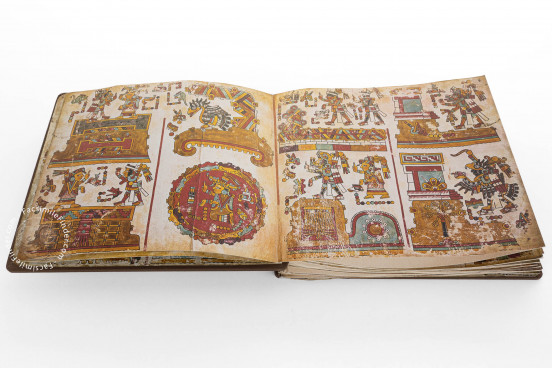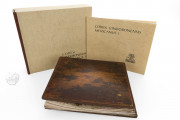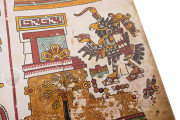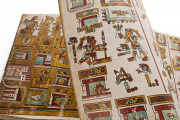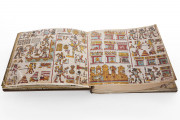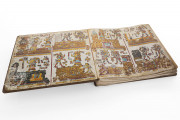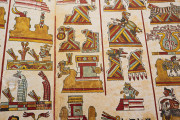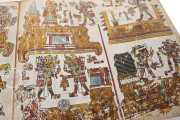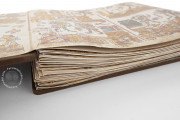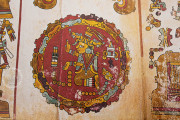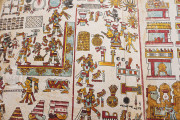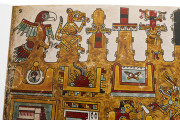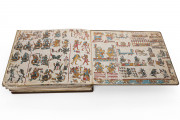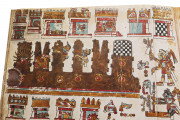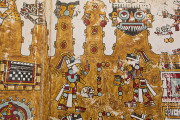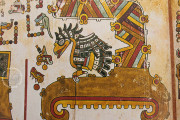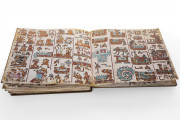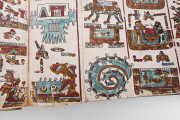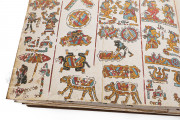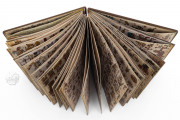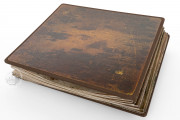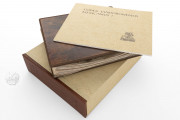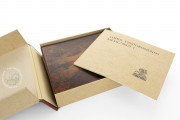The Codex Yuta Tnoho, also known as the Codex Vienna (Codex Vindobonensis), is a rare preconquest screenfold manuscript from Mixteca dating from the second half of the fifteenth century and the early sixteenth century. It narrates the mythological origins, genealogy, and dynastic history of rulers of the city-state of Tilantongo stretching from the beginning of the universe to the fourteenth century. Vibrant images composed of traditional Mesoamerican pictographs use symbols and signs to represent places, dates, deities, priests, and rulers.
The screenfold was fashioned from fifteen strips of deerskin glued together to form a single, long strip covered on both sides with a thin layer of plaster to receive paint. It is folded accordion-style into fifty-two panels, each 22.5 × 25.5 cm. All fifty-two pages of the obverse and thirteen pages of the reverse are occupied by hundreds of images of individual human figures and objects.
One Screenfold, Two Painter-Scribes
Two painter-scribes created the manuscript. The obverse was painted by a skillful practitioner of the traditional art of pictographs. Its ambitious content is thoroughly planned out and polished in its execution. Thin red lines help guide the reader through the narrative's exposition, moving across the pages from right to left—confusingly prominently numbered in the opposite direction—largely in an up-and-down boustrophedon (zig-zag) pattern. Figures and glyphs are generally outlined in black and filled with rich tones of red, ocher, bright blue, and pink.
The images on the obverse mostly stand out against the white surface of the underlying plaster. Ocher is strikingly used as a background color, creating two imposing pages (pp. 10-9) that mark the transition to a ten-page section devoted to the founding of the Mixtec city-states.
A Hasty Addition
Only thirteen pages of the reverse received paintings, and those were executed by a second, less accomplished painter-scribe working in the same traditional palette used on the obverse. He may have been working under time constraints, and it has been speculated that this purely genealogical content was added at the time the manuscript was presented to the conquistador Hérnan Córtes. The contents in three registers are arranged right to left (although numbered left to right), with the boustrophedon pattern of reading being from the top to the bottom of each page.
A Universal History
The obverse of the Codex Yuta Tnoho provides a comprehensive view of cosmic order and the divine origins of Mixtec rulership unequaled in the other surviving Mixtec pictorial manuscripts. It begins in heaven with the beginning of the cosmos (pp. 52-38). Then the divine ancestors of the Mixtec dynasties are born from the great tree and named (pp. 37-27). Rituals involving maize, pulque, and hallucinogenic mushrooms (pp. 27-23) lead to the beginnings of human history (pp. 22-11) and the founding of the city-states (pp. 10-1).
Focus on Local Concerns
The paintings of the manuscript's reverse, added a generation or more after the obverse was painted, present a rather muddled genealogy of the rulers of Tilantongo, bringing the cosmological content of the obverse into local focus.
A Dazzling History of Ownership
Although it can only be a matter of speculation that the Codex Yuta Tnoho was presented to Cortés by an indigenous leader, it is a matter of record that the manuscript was in Europe by 1521. It was in the collection of Manuel I (1469-1521), King of Portugal, before passing through the hands of Giulio de' Medici (1478-1534); Ippolito de' Medici (1513-1535); Nikolaus von Schönberg (1472-1537); and Schönberg's secretary Johann Albrecht Widmanstetter (d. 1557).
Widmanstetter wrote an inscription in Latin in the manuscript recounting some of its history: he was also responsible for its conveyance to Bavaria. Starting in 1558, the manuscript was in the collection of the Bavarian dukes Albrecht V, Wilhelm V, and Maximilian I. After the 1632 sack of Munich in the Thirty Years War, the manuscript came into the possession of Wilhelm IV, Duke of Saxe-Weimer, then Johann Georg I, Duke of Saxe-Eisenach, who presented it in 1678 to Leopold I, Holy Roman Emperor. In 1705, it entered the collection of the Austrian Imperial Library, renamed the Österreichische Nationalbibliothek after World War II.
We have 1 facsimile edition of the manuscript "Codex Yuta Tnoho": Codex Vindobonensis Mexicanus 1 facsimile edition, published by Akademische Druck- u. Verlagsanstalt (ADEVA), 1974
Request Info / Price
